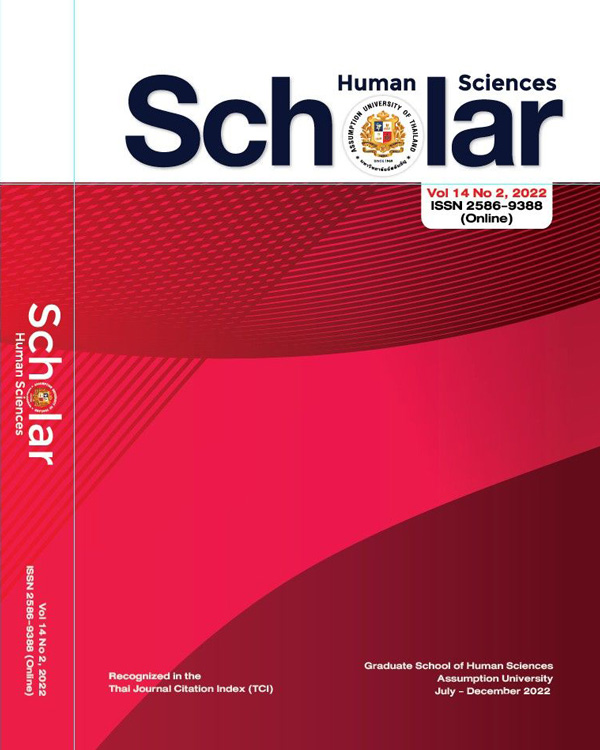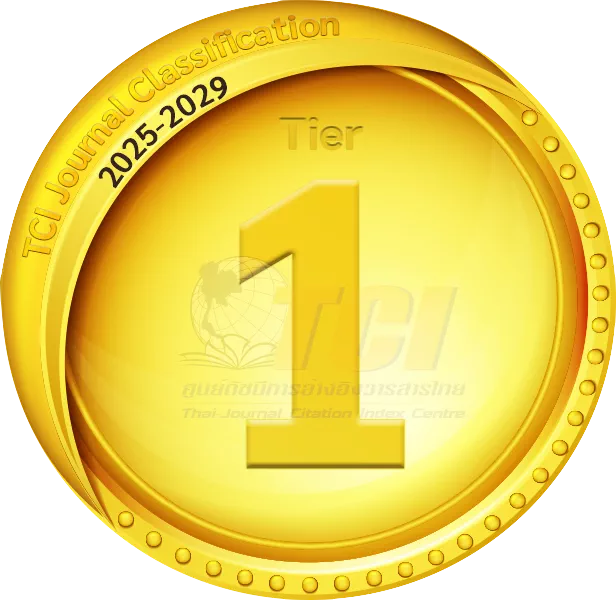A CORRELATIONAL–COMPARATIVE STUDY OF MOTIVATION AND PERCEIVED PARENTAL ENCOURAGEMENT FOR LEARNING CHINESE AS A FOREIGN LANGUAGE OF GRADES 5 AND 6 STUDENTS AT KHLONG TOEI WITTAYA SCHOOL, BANGKOK, THAILAND
Keywords:
Motivation, Perceived Parental Encouragement; Chinese As a Foreign Language; Socio-Educational Model; Attitude/Motivation Test Battery (Amtb); Khlong Toei Wittaya School;Abstract
The purpose of this study was to determine the relationship between Grades 5 and 6 students' motivation and their perceptions of parental encouragement for learning Chinese as a foreign language and to compare two variables in grades 5 and 6 levels at Khlong Toei Wittaya School, Bangkok, Thailand. The participants of this study were 109 students from Grades 5 and 6 at Khlong Toei Wittaya School, Bangkok, Thailand. This study was designed as a quantitative correlational-comparative study. An adapted version of Gardner's (2004) Attitude/Motivation Test Battery (AMTB) was used to collect data from 61 Grade 5 and 48 Grade 6 students during the 2019-2020 academic year. Descriptive statistics means standard deviations, correlational analysis (Pearson's product-moment correlation coefficient), and an independent samples t-test (2-tailed) were used to analyze the data. The study found that Grades 5 and 6 students' motivation for learning Chinese as a foreign language at Khlong Toei Wittaya School and their perceptions of parental encouragement for learning Chinese as a foreign language were slightly high. Also, a significant positive relationship between motivation and perception of parental encouragement for learning Chinese as a foreign language was found for each grade level. Furthermore, the findings also indicated no significant difference between Grades 5 and 6 students' motivation for learning Chinese as a foreign language and no significant difference between their perceptions of parental encouragement for learning Chinese as a foreign language.
References
Alizadeh, M. (2016). The impact of motivation on English language learning. International Journal of Research in English Education, 1(1),11-15. Retrieved from http://ijreeonline.com/article-1-23-en.pdf Angelova, M., & Zhao, Y. (2016). Using an online collaborative project between American and Chinese students to develop ESL teaching skills, cross-cultural awareness, and language skills. Computer Assisted Language Learning, 29(1), 167-185.
Cortes, C. M. (2002). The relationships between attitude, motivation, anxiety, and proficiency in English as a second language of first-year university students in Puerto Rico (Order No. 3058307). Available from ProQuest Dissertations & Theses Global. (276484025). Retrieved from https://search.proquest.com/docview/276484025
Dӧrnyei, Z. (1998). Motivation in second and foreign language learning. Language Teaching, 31(3), 117-135. Retrieved from https://docs.wixstatic.com/ugd/ba734f_a4b28c85c4604338af26d4b1bdd29f39.pdf
Dӧrnyei, Z. (2003). Attitudes, orientations, and motivations in language learning: Advances in theory, research, and applications. Language Learning, 53(1), 3-32. Retrieved from https://docs.wixstatic.com/ugd/ba734f_208c81cbb9d3453bbc529d68e3ae65a0.pdf
Feldscher, K. (2015). Obama wants 1 million Americans to learn Chinese by 2020. Washington Examiner.
Gao, H. (2011). An analysis of the phenomenon of global "Mandarin fever." Asian Social Science, 7(12), 253-257. Retrieved from http://www.ccsenet.org/journal/index.php/ass/article/viewFile/13442/9352
Gardner, R. C. (1985a). The attitude/motivation test battery: Technical report (1985). Retrieved from http://publish.uwo.ca/~gardner/docs/AMTBmanual.pdfGardner, R. C. (1985b). Social psychology and second language learning: The role of attitudes and motivation. London: Edward Arnold. Retrieved from http://publish.uwo.ca/~gardner/docs/SECONDLANGUAGE1985book.pdf
Gardner, R. C. (2005). Integrative motivation and second language acquisition. Canadian Association of Applied Linguistics/Canadian
Scholar: Human Sciences, ISSN 2586-9388, Vol.14 No.2 (Jul.-Dec. 2022)
Linguistics Association Joint Plenary Talk-May 30, 2005, London, Canada. Retrieved from http://publish. uwo. ca/~ Gardner/docs/caaltalk5final. pdf
Gardner, R. C. (2009). Gardner and Lambert (1959): Fifty years and counting. Paper presented at the Canadian Association of Applied Linguistics annual meeting, Ottawa. Retrieved from http://publish. uwo. ca/~gardner/docs/CAALOttawa2009talkc. pdf
Gardner, R. C. (2010). Motivation and second language acquisition: The socio-educational model (Vol. 10). New York: Peter Lang.
Gu, M. (2009). College English learners' discursive motivation construction in China. The system, 37(2), 300-312.
Henderson, A.T (2002) A new wave of evidence: The impact of school, family and community connections on student achievement. pp.24-41
Hidi, S., & Harackiewicz, J. M. (2000). Motivating the academically unmotivated: A critical issue for the 21st century. Review of Educational Research, 70(2), 151-179.
Hou, J., & Lynch, R. (2016). A correlative study of motivation for learning Chinese according to academic achievement and parental encouragement among grade four to grade six students at Ladprao Bilingual School (LBS), Bangkok, Thailand. Scholar: Human Sciences, 8(2), 94-105. Retrieved from http://www.assumptionjournal.au.edu/index.php/Scholar/article/view/2501
Huang, E., & Lynch, R. (2019). The relationship of motivation for learning Chinese and perceptions of parental encouragement for learning Chinese with Chinese academic achievement of Grade 3, Grade 4, and Grade 5 students at an international school in Thailand. Scholar, Human Sciences, 11(1), 70-79.
Jeynes, W. H. (2005). A meta-analysis of the relation of parental involvement to urban elementary school student academic achievement. Urban Education, 40(3), 237-269. Retrieved from http://journals.sagepub.com/doi/pdf/10.1177/0042085905274540
Kanoksilapatham, B. (2011). The national survey of teaching Chinese as a foreign language in Thailand. Southeast Asian Ministers of Education Organization.
Lawrence, A., & Barathi, C. (2016). Parental encouragement concerning the academic achievement of higher secondary school students. Online Submission, 2(6), 1234-1239. Lin, M. L. (2011). Research for Ramkhamhaeng University of Learning Thai Students Learning Chinese, and Motivation Survey (Order No. 10551972). Available from ProQuest Dissertations & Theses Global.
Scholar: Human Sciences, ISSN 2586-9388, Vol.14 No.2 (Jul.-Dec. 2022)
(1874397192). Retrieved from https://search.proquest.com/docview/1874397192?accountid=8401 MacIntyre, P. D., Potter, G. K & Burns, J. N. (2012). The socio-educational model of music motivation. Journal of Research in Music Education, 60(2), 129 –144. Retrieved from https://journals.sagepub.com/doi/abs/10.1177/0022429412444609
MacIntyre, A., & Dunne, J. (2002). Alasdair MacIntyre on education: In dialogue with Joseph Dunne. Journal of Philosophy of Education, 36(1), 1-19.
O'Flahavan, J., Gambrell, L. B., Guthrie, J., Stahl, S., & Alvermann, D. (1992). Poll results guide the activities of the research center. Reading Today, 10(1), 12.
Penjak, A., & Karninčić, H. (2015). Attitudes, motivation and parental encouragement in learning English as a foreign language: The Croatian context. Journal of Foreign Languages, Cultures and Civilizations, 3(2), 17-23. Retrieved from https://jflcc.com/journals/jflcc/Vol_3_No_2_December_2015/3.pdf
Timberlake, W., Mowrer, R., & Klein, S. (2001). Motivational modes in behavior systems. Handbook of Contemporary Learning Theories, 155-209.
Varişoğlu, M. C. (2016). The importance of strategies of social language learning and cooperative learning in the process of teaching Turkish as a foreign language. Educational Research and Reviews, 11(10), 981-986.
Vijchulata, B., & Lee, G. S. (1985). A survey of students' motivation for learning English. RELC Journal, 16(1), 68-81.
Yu, B. (2010). Learning Chinese abroad: The role of language attitudes and motivation in the adaptation of international students in China. Journal of Multilingual and Multicultural Development, 31(3), 301-321.
Zhu, R. L. (2011). Thai students learning Chinese psychological research and analysis (Order No. 10548133). Available from ProQuest Dissertations & Theses Global. (1874969607). Retrieved from https://search.proquest.com/docview/1874969607?accountid=8401
Downloads
Published
How to Cite
Issue
Section
License
The submitting author warrants that the submission is original and that she/he is the author of the submission together with the named co-authors; to the extend the submission incorporates text passages, figures, data, or other material from the work of others, the submitting author has obtained any necessary permission.
Articles in this journal are published under the Creative Commons Attribution License (CC-BY What does this mean?). This is to get more legal certainty about what readers can do with published articles, and thus a wider dissemination and archiving, which in turn makes publishing with this journal more valuable for you, the authors.




